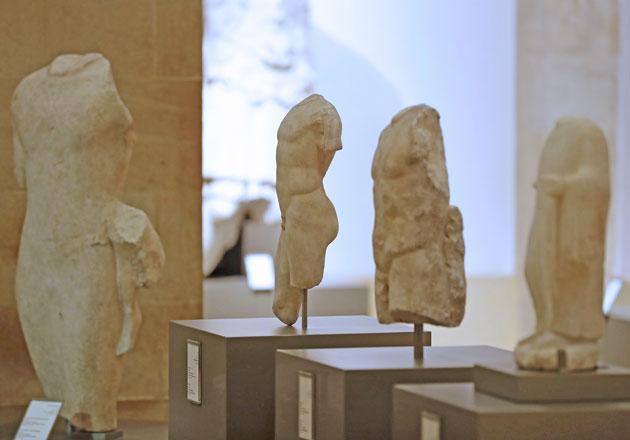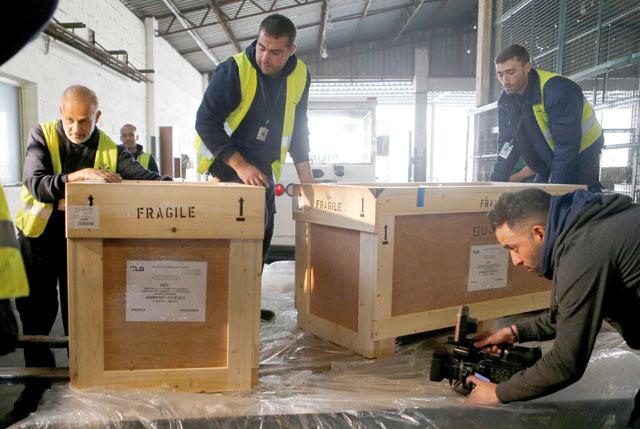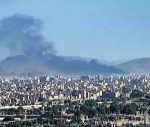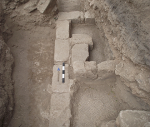You are here
On Achaemenid architectural influences in Levantine region
By Saeb Rawashdeh - Oct 02,2024 - Last updated at Oct 02,2024

Temple of Amrit near Tartus (Photo courtesy of World Monuments)
AMMAN — Achaemenid Empire (559 BC – 330 BC) exercised political influence in the Levant but a few monuments remained in this part of the Middle East that were typical for Achaemenid architecture.
These decorations were occasionally mixed with oriental and Greek influences. The bearded sphinxes wearing a flat hat that adorned the three-cornered Greek-type triangular facade of the Temple of Eshmun knew as the pediment, however, is a mixture sculpture art between the funeral sculptures of Greece and the architectural bas-reliefs of Persepolis, noted a Jordanian scholar.
"In other words, Temple of Eshmun combines the form of the most familiar temples in Athens and the Achaemenid sculptures in Persepolis," highlighted Hashem Khreis from the German Protestant Institute of Archaeology.
"The protomes of bulls that adorned Eshmun Temple as bull-shaped capitals portrayed in crouched positions, however, are pure Achaemenid influences appeared for the first time in the Palaces of Darius I at Persepolis and Susa established in the beginning of the 5th century BC," Khreis added.
In the Temple of Eshmun at Sidon the bulls had tiny and clumsy ears and hoofs, short spiral horns, hidden nostril, heads without necks, and the chin is stuck into the body with no any patterning, he explained.
Khreis noted that the battlement friezes commonly called as pinnacles or stepped merlons with rectangular blocks resembles the teeth known as a “dentil frieze” beneath them are one of the most imported characteristic features of this period in the Levant.
Moreover, the merlons embellishing the eastern stairwell of the Apadana of the Palace of Darius I at Persepolis had four stepped right-angled steps each, equal in depth and high with a niche in the bottom centre.
"This recess contained two successive and deep holes located directly under the last step at a high less than the second one. The merlons ornamenting the peak and the foot of the shrine of the Temple of Amrit, near Tartus, contained four stepped steps ascending at right angles each," Khreis said, adding that the steps have equal shallow depths and low heights.
At the bottom of the steps there are two lateral niches instead of one in the centre. The merlons in the palace of Persepolis are separated by equal distances one from the other while the pinnacles in Amrit are attached. The pinnacles found on the ground of the remains of the Temple of Tell Sukas, in Jableh in Syria on the northern coast of the Levant, however, contained three steps each and were of unequal depths and highs, Khreis elaborated.
Owing to its unique geographic location, the Levant has always been a point of contact between the Middle East and the external world; however, the Persians had not such strong cultural influence on the inhabitants of the Levant as the Egyptians had.
"Perhaps, they did not have the capacity to counteract and rid this part of their empire of the substantial impact of the Egyptian cultural presence which is rooted deeply in the history of the Levant since the Bronze Ages. Regardless, the palatial and luxurious palaces in Iran erected between the 5th and 4th centuries BC," Khreis said.
He added that splendour was reserved for imperial buildings in capitals Persepolis, Susa and Pasargadae.
The bulls' sculptures in the architecture of the Persian period in the Levant were not solely architectural or ornamental elements but were part of Persian belief system.
"It is known to archaeologists that this iconography depicted the god Hadad- the supreme deity of the Phoenicians and Syrians since the first millennium BC.
The Levant in the Persian period had witnessed a peaceful interaction of different cultures and religions and the fact that societies are becoming more diverse," Khreis said, adding that the Achaemenid influence in the Levantines religious life was not completely absent.
Furthermore, the stepped pinnacles and related religious connotations used by the Phoenicians in the sacred buildings represent direct Achaemenid impacts that are inspired, in turn, by their ancestors; the Elamites, he underscored.
"To sum up, the Persian effects on the Levantine architecture were at the lowest and confined to a few structures on the Phoenician coast specifically," Khreis said.
He noted that the Achaemenid cultural influences that have appeared clearly on the Phoenician coast, however, did not exist to the same degree in the southern hinterland of the Levant.
Related Articles
BEIRUT — Ancient sculptures that were missing for decades after being stolen during Lebanon’s civil war are to go on display in Beirut thank
AMMAN — During the Bronze Age, Cyprus played a role of cultural and economic hub, as well as a bridge between the Levant and southern Europe
BEIRUT — A marble bull’s head made 2,400 years ago for a Phoenician temple and looted during Lebanon’s civil war arrived in Beirut on Friday


















